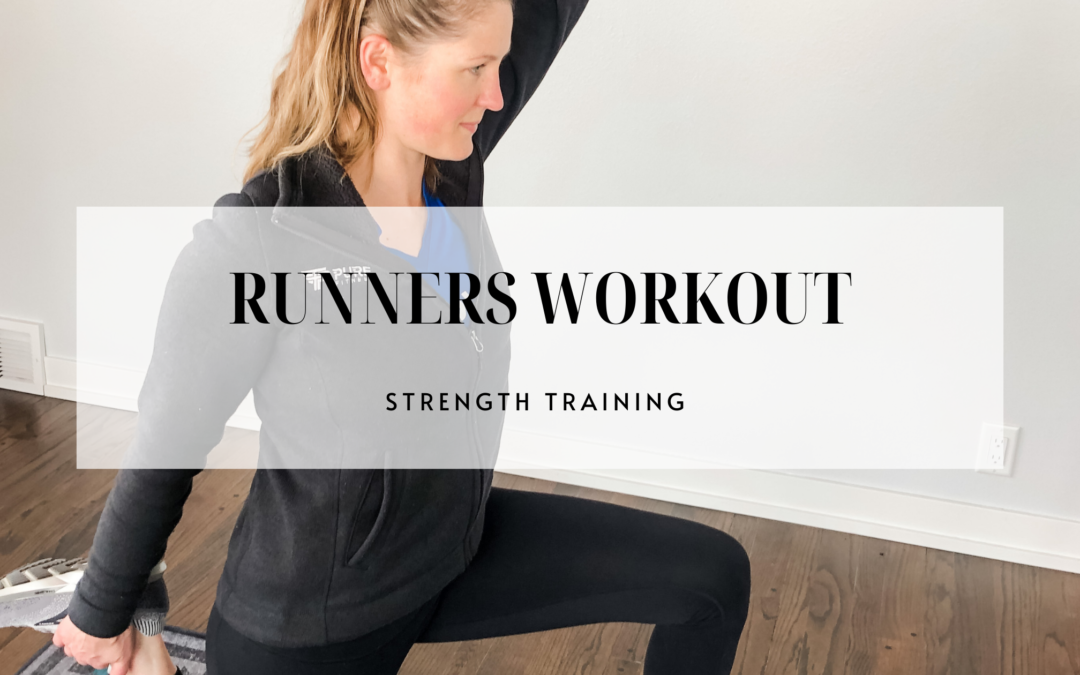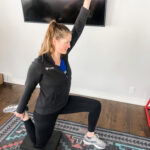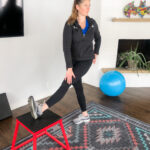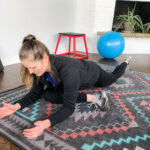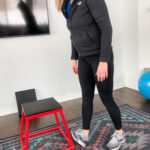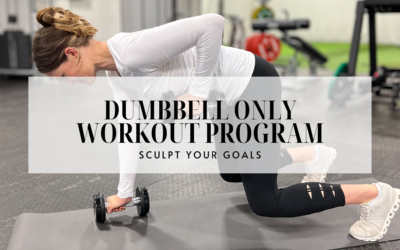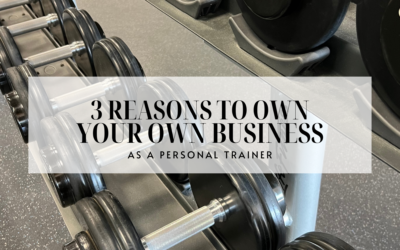I am a self-proclaimed “non-runner” runner. My love isn’t for running, but for the feeling of accomplishment. I am not passionate about running, but rather the discipline it takes to get better. Running is my outlet because it is available, it is challenging and I am struggling to get better. That’s where strength training for my “non-runner” running comes in.
After years for sprinting out the door, trying to better and faster than the day before I got myself an education, Literally. I got a degree in Exercise Science. I learned the value of strength training to improve running performance and the balance between volume work and interval training.
WHY SHOULD RUNNERS STRENGTH TRAIN
 There are many reasons why runners and “non-runner” runners should be strength training weekly. But here are my top three:
There are many reasons why runners and “non-runner” runners should be strength training weekly. But here are my top three:
- Injury Prevention. I cannot count the number of running related injuries that come from OVER running. Imagine if those people just swapped 2-3 workouts a week for strength training. They likely never would have gotten shin splints or patellar tendonitis. Including strength training in a running program will help protect the body and lay the ground work to fun faster and longer.
- Muscular Stability and Strength Balance. Repetitive actions, such as running, put your body in a box. Demanding the same muscles and often ignoring others. Overtime the balance in your muscular system will become uneven and pain and discomfort will start before, during and after running. This will limit your ability to run. It can sideline runners for months and the pain could creep into every part of your life. Through strength training you can ensure proper muscle firing patterns and strength symmetry to keep yourself moving.
- Performance. You will not, I repeat you will not, find any high level runners that are not strength training. They can be sprinters, marathon runners, triathletes, professional, collegiate or aspiring. They are all strength training. But you may need to adjust your perspective of strength training. Although all of these athletes are running, they will strength train differently targeting muscular endurance or muscular strength based on their sport
BEST EXERCISES TO WARM-UP FOR RUNNING
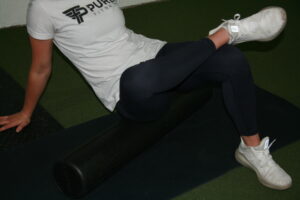
There are many ways to warm-up and I am not here to tell you my way is the best. Instead I want to give you some options to explore and a little bit of science. First, let me tell you that warming up might take a few extra minutes, but you will feel better during and after.
The goal of a warm-up is to raise your body temperature and therefore you muscles so that they can be responsive under the stress of exercise. Part of this process should be “awakening” or activating the muscles you want to help you perform. So in the case of running we want to really warm-up our lower body and core. And typically this takes around 10 minutes.
I know you are now like this woman is crazy. She wants me to add 10 minutes on to my workout. Well if time was no issue that would be great. But you can pair one of the next three options with a SLOW start to running. Increasing your speed for the first 5 minutes of your run.
My preferred way to warm-up is through dynamic movement. I slowly increase my heart rate, body temperature and focus on using specific muscles. Although sometimes a good foam rolling session is what I need to get my feet to the street 😜. And at the very least I will do some muscle activation. Take a look at these three ways to warm-up.
- Foam Roll: glutes, IT band, quads, hamstrings + calves
- Muscle Activation: glute bridge, figure 4 glute bridge, deadbug, bear stance to plank
- Dynamic Warm-Up: reverse lunge + rotate with knee drive + toe lift, lateral lunge + twist with knee drive + crunch, forward lunge + side bend with knee drive + toe lift.
If you are looking for a less running specific warm-up routine to use on strength training days or just to get your body moving check out this blog.
BEST EXERCISES TO STRENGTH TRAIN FOR RUNNING
I have put together two strength sets, legs + core, you can try incorporating into your weekly training. My intention was to provide you a challenging program that can be done body weight or with resistance. You can also vary the repetition numbers based on your training situation.
There is a lot I want to say about selecting weight and repetitions, but it’s just too much. I’d be writing for days and there are textbooks and research papers you can read if you really want to know. But I do want to give you a few general guidelines.
First, quad dominance is extremely common in runners. Your strength program should help you avoid or manage that. That is why the exercises I have laid out show a huge focus on hamstrings and glutes. There is also a high demand on your hips and calves so I have incorporated additional movements that may make you feel uncoordinated, unbalanced or just slow. Take your time, it get’s easier. And finally, we are trying to work in multiple planes of movement and muscle contractions to increase your stability so you can be faster and healthier.
This all goes back to what I was talking about above – muscle firing patterns and strength balance.
Second, if you are training for a long distance race you are going to want to be working in muscle endurance. That means your rep count will be higher and your weight will likely be lower. Think reps 15-20 and find a weight that allows you to finish all your reps. And if you are new to strength training, regardless of distance, start with 8-10 reps and no weight. Make sure you are using the correct muscles and form.
That last bit goes for everyone – quality over quantity. Any exercise, no matter how great, done incorrectly (especially done incorrectly repetitively) will lead to an injury at some point.
Third, don’t trick yourself into thinking a week of strength training should change your mile splits. Results will come with consistent, long-term practice. Nothing happens overnight. But, every runner I have worked, with who started incorporating weekly strength training, felt better within a few weeks. Hold on to that thought as you hobble around after these workouts 🙃.
If you want to read a little bit about how you can use various types of interval training for your strength training check out our blogs on HIIT and Tabata. When used correctly, as described in the article (probably not what you are currently doing), they can vast improve someones cardio vascular capabilities.
And one more thing … even runners need an off-season. You should have time built in to work on your strength imbalances or weaknesses. Time to give back to your body so that you can push it further next time. A lot of progress (read: faster + healthier) is made by gaining muscular strength in the off-season and translating that newly built strength into muscular endurance. Chew on that.
RUNNERS LEG WORKOUT
- Single Leg Hamstring Curl – try going slow on the extension to make this an eccentric exercise, add a single leg glute bridge to take it to the next level.
- Side Step-Up with Knee Drive + Toe Lift to Curtsey Lunge – be sure to control your leg/body back down to the ground and really feel your glutes burn.
- SL Box Squat – once you can control the entire phase down, try going slow and make this an eccentric exercise.
- Bulgarian Split Squat with Rotation – focus on strength and stability in the bottom position as you rotate.
- Hip Circle to Reverse Lunge with Knee Drive + Toe Lift – keep your upper body still as you perform the hip circle, really brace your core to maintain balance.
RUNNERS CORE WORKOUT
- Runner Extensions – purposeful movements at a moderate pace, increase band resistance or reps as your strength increases.
- Side Plank Rotate, Raise + Crunch – push the ground away through your elbow and focus on the connection of your core from hips to shoulders.
- Bicycle to Flutter Kick – feel your low core and hip flexors fire as you keep your spine neutral and core engaged.
- Negative Flutter Kicks – an eccentric and concentric load for your core + hip flexors, try to get as many flutters as you can before your feet get to the ground.
- Bear Stance Kick Up + Kick Through – focus on keeping your pelvis stable as you kick up and feel the rotation through your belly button as you kick through.
BEST EXERCISES TO COOL DOWN FROM RUNNING
Now you have read everything so far. I’m impressed. That tells me you are serious about taking care of your body as supporting your habit of running. PLEASE PLEASE PLEASE cool down after running. I know I have made a big deal about every phase of running, but I have to. So many of the running related injuries or set backs I see are completely avoidable. Part of avoiding them is cooling down.
I asked you for 10 minutes of a warm-up and now I am asking you for 5 minutes of a cool down. You can hit all those muscles I talked about above with a foam roller again or you can do static stretching.
Either way you just spent some amount of time woking out (running). That means your muscles were contracting the entire time to produce the movement. Prioritizing the time to release the tension from the contractions and focus on lengthening will speed up your recovery between runs, decrease risk of injury and decrease your soreness.
Here are four of my preferred cool down static stretches: quad stretch, IT band stretch, glute/hip stretch and calf stretch.
We have a lot of information on our website about recovery. Here are just a few of my favorites: favorite cool down + 5 recovery tools to use.
WRAP IT UP
I said it before, but I don’t run because it makes me happy or because I get some amazing runner’s high. The challenge is why I run. The understanding that with continued training and practice I can see how far my body will take me. Hopefully you found a little nugget or 10 in this article to take with you into your next run and training. As always contact me below if you are looking for help with your run training!
Unlock Your Full Potential: The Bodyweight Workout Program
Are you looking to transform your body, boost your fitness, and achieve your health goals without the need for expensive gym memberships or fancy equipment? Look no further! I have an amazing solution for you, my Bodyweight Workout Program. In today's fast-paced...
Sculpt Your Goals: Dumbbell Only Workout Program
Are you ready to start a new workout program that focuses on building strength in a simple and effective manner? Then you are in the right place! My Dumbbell Only Workout Program is your answer to achieving your fitness goals. Let's explore why my program is the...
3 Reasons to Own Your Own Training Business
Owning your own training business can be an exciting and yet overwhelming thought. But ask yourself... Are you committed to the long term? Does passion and knowledge fuel your desire to work with clients everyday? Are you looking for more career advancement...


